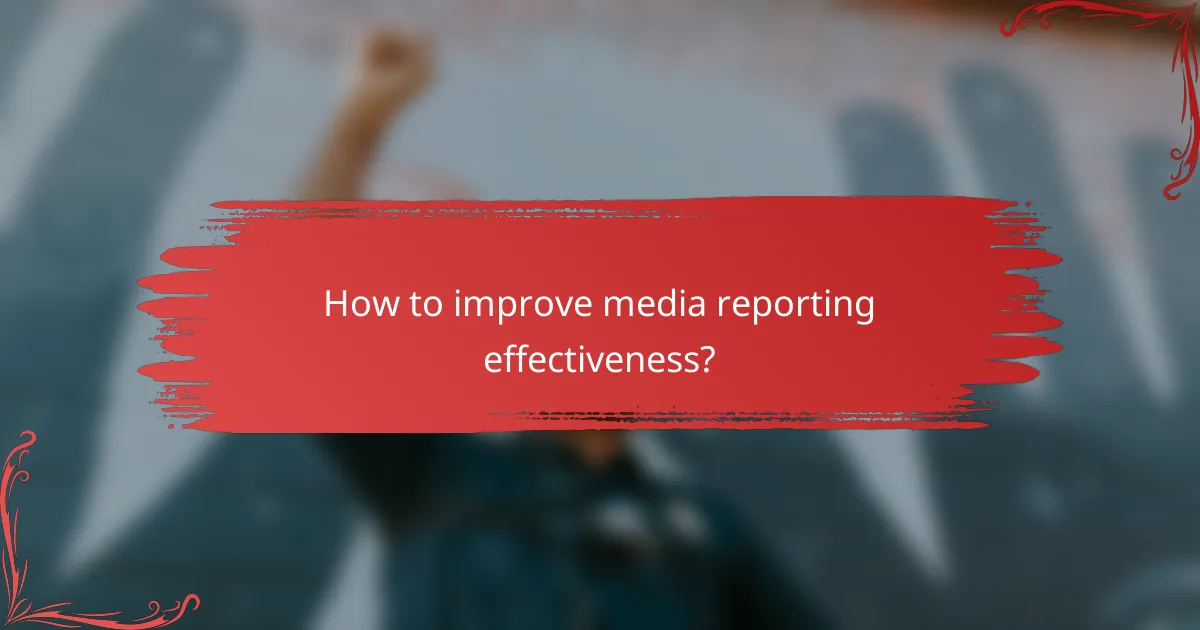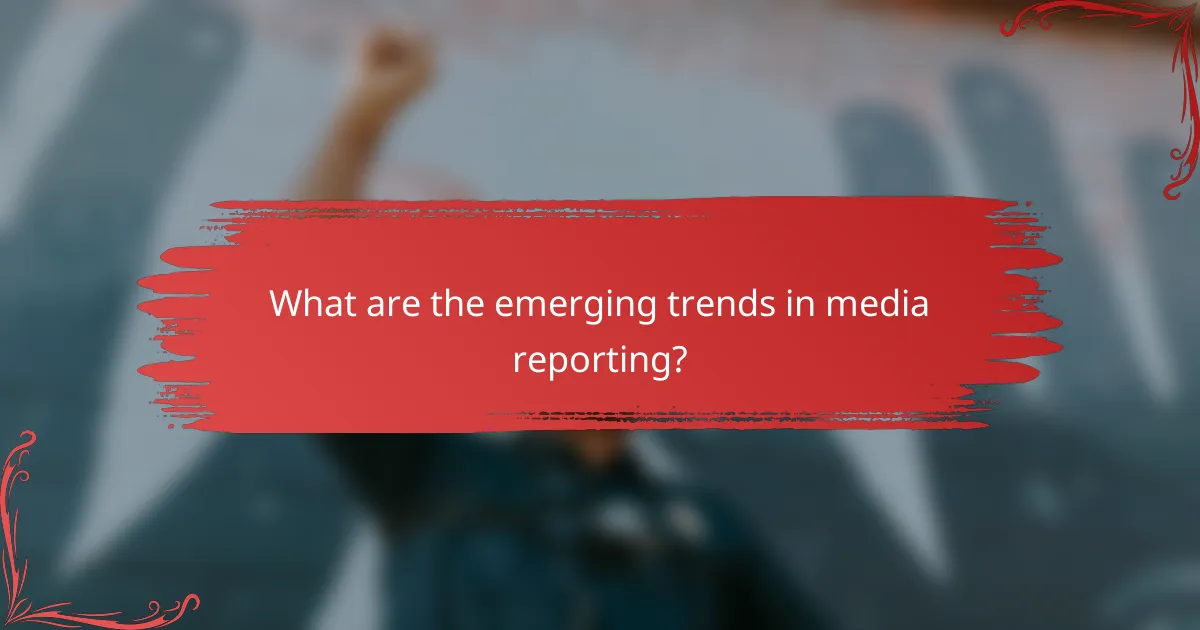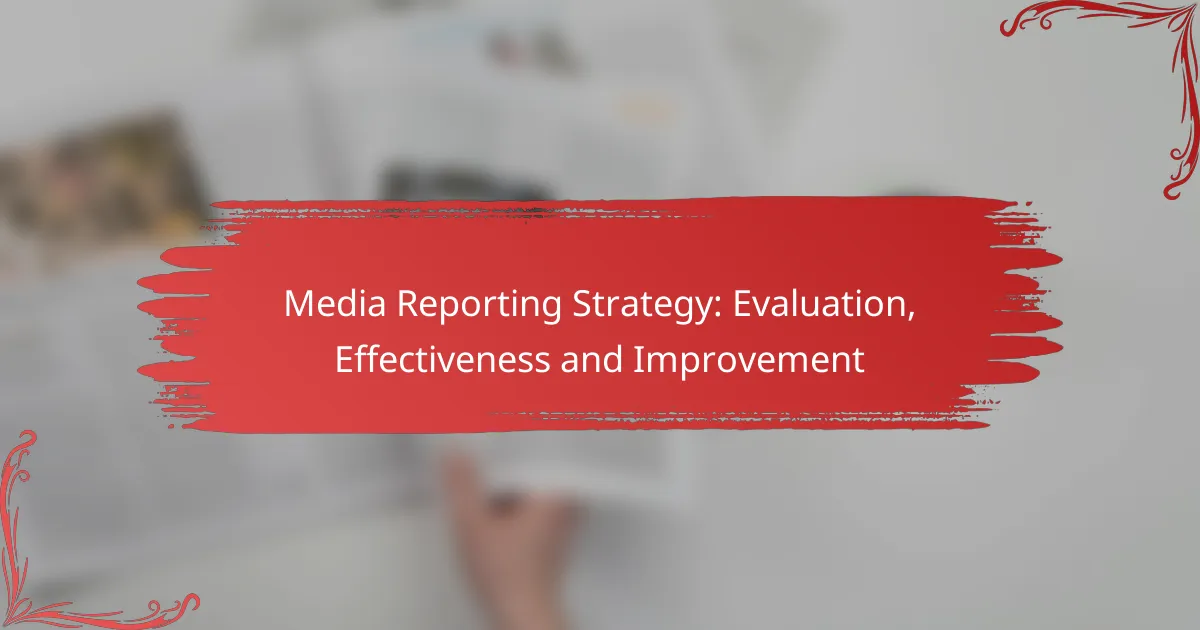Media reporting strategies play a crucial role in shaping public perception and understanding of news. By evaluating their effectiveness through specific metrics, organizations can identify areas for improvement, ensuring that content remains accurate, engaging, and relevant to audiences. Continuous enhancement of these strategies, including journalist training and the use of technology, is essential for maintaining high standards in reporting.

How to evaluate media reporting strategies in the US?
Evaluating media reporting strategies in the US involves assessing their effectiveness through various metrics and benchmarks. This process helps identify strengths and weaknesses, guiding improvements in content delivery and audience engagement.
Key performance indicators for evaluation
Key performance indicators (KPIs) are essential for measuring the success of media reporting strategies. Common KPIs include audience reach, impression counts, and conversion rates. These metrics provide a quantitative basis for assessing how well a strategy performs against its goals.
When selecting KPIs, focus on those that align with your specific objectives. For instance, if the goal is to increase readership, track unique visitors and page views. Regularly review these indicators to adapt strategies as needed.
Benchmarking against industry standards
Benchmarking involves comparing your media reporting strategies to established industry standards. This process helps identify gaps and areas for improvement. Utilize resources like industry reports and competitor analysis to gather relevant data.
Consider metrics such as average engagement rates or content shareability within your niche. By understanding where you stand relative to peers, you can set realistic goals and enhance your reporting strategies effectively.
Audience engagement metrics
Audience engagement metrics are crucial for understanding how well your content resonates with readers. Key metrics include time spent on page, social media shares, and comments. These indicators reveal the level of interest and interaction your reporting generates.
To improve engagement, analyze which topics or formats yield the highest interaction rates. Experiment with different styles, such as infographics or videos, to see what captures your audience’s attention most effectively.
Content accuracy assessments
Assessing content accuracy is vital for maintaining credibility in media reporting. Implement fact-checking processes and peer reviews to ensure information is reliable. Regular audits can help identify inaccuracies and improve overall content quality.
Consider using third-party fact-checking services or tools to enhance your accuracy assessments. Establishing a reputation for accuracy can significantly boost audience trust and loyalty.
Feedback from stakeholders
Gathering feedback from stakeholders, including readers, editors, and advertisers, is essential for evaluating media reporting strategies. Surveys, interviews, and focus groups can provide valuable insights into audience perceptions and preferences.
Actively seek constructive criticism and be open to implementing changes based on feedback. This iterative process can lead to continuous improvement in your reporting strategies, aligning them more closely with audience expectations and industry trends.

What are effective media reporting strategies?
Effective media reporting strategies focus on delivering accurate, engaging, and relevant content to the audience. These strategies enhance the clarity and impact of news stories, ensuring that they resonate with readers and viewers.
Data-driven storytelling techniques
Data-driven storytelling techniques involve using quantitative information to support narratives. This approach can enhance credibility and provide readers with a clearer understanding of complex issues. For instance, incorporating statistics, charts, or infographics can help illustrate trends and make the content more digestible.
When employing data, ensure it is sourced from reputable organizations and presented in a straightforward manner. Avoid overwhelming the audience with excessive numbers; instead, focus on key figures that highlight the story’s main points.
Utilizing multimedia elements
Utilizing multimedia elements such as videos, images, and audio clips can significantly enhance media reports. These elements engage audiences more effectively than text alone, making stories more compelling and memorable. For example, a short video interview can provide a personal touch that written quotes may lack.
When integrating multimedia, ensure that it complements the written content rather than distracts from it. Use high-quality visuals and maintain a balance between text and media to keep the audience focused on the story.
Leveraging social media platforms
Leveraging social media platforms is crucial for modern media reporting, as these channels facilitate real-time engagement with audiences. Journalists can share updates, gather feedback, and even crowdsource information, which can enrich their reporting. Platforms like Twitter and Facebook allow for quick dissemination of news and foster community discussions.
To maximize effectiveness, tailor content for each platform. For instance, use concise, impactful headlines for Twitter, while longer, more detailed posts may work better on Facebook. Monitor audience interactions to refine future reporting strategies.
Collaborative reporting models
Collaborative reporting models involve partnerships between journalists, organizations, and even audiences to produce comprehensive stories. This approach can pool resources, expertise, and perspectives, leading to richer narratives. Examples include joint investigations or shared databases that enhance transparency and accountability.
When engaging in collaborative efforts, establish clear communication and roles among all parties involved. This ensures that the final product is cohesive and maintains journalistic integrity while benefiting from diverse insights.

How to improve media reporting effectiveness?
Improving media reporting effectiveness involves enhancing the skills of journalists, establishing robust feedback mechanisms, leveraging technology, and conducting regular content evaluations. These strategies collectively ensure that reporting meets audience needs and maintains high standards of accuracy and relevance.
Training for journalists
Training is essential for journalists to stay updated on best practices, ethical standards, and emerging trends in media. Workshops, online courses, and mentorship programs can help develop critical skills such as investigative reporting, data journalism, and multimedia storytelling.
Consider implementing a continuous learning culture where journalists regularly participate in training sessions. This could include guest lectures from industry experts or collaborative projects with educational institutions to enhance practical knowledge.
Implementing feedback loops
Feedback loops are vital for assessing the impact of media reports and improving future content. Establishing channels for audience feedback, such as surveys or social media interactions, allows journalists to understand public perception and areas for improvement.
Additionally, internal reviews among editorial teams can provide constructive criticism. Regularly scheduled meetings to discuss feedback can help identify recurring issues and foster a culture of accountability and growth.
Adopting new technologies
Incorporating new technologies can significantly enhance media reporting effectiveness. Tools such as data analytics, AI-driven content creation, and social media monitoring can streamline workflows and provide insights into audience preferences.
For instance, using analytics platforms can help identify which stories resonate most with readers, allowing journalists to tailor their reporting accordingly. Investing in training for these technologies ensures that staff can fully leverage their potential.
Regular content audits
Conducting regular content audits helps maintain the quality and relevance of media reports. This process involves reviewing existing content to assess accuracy, engagement, and alignment with current audience interests.
Establish a schedule for audits, such as quarterly or bi-annually, to systematically evaluate content performance. Use metrics like reader engagement and feedback to inform decisions on updates or removals of outdated articles, ensuring that the media remains credible and valuable to its audience.

What frameworks exist for media reporting evaluation?
Several frameworks can be utilized for evaluating media reporting, focusing on both internal and external factors. These frameworks help assess the effectiveness of media outlets and their responsiveness to changing environments.
SWOT analysis for media outlets
SWOT analysis evaluates the Strengths, Weaknesses, Opportunities, and Threats of a media outlet. Strengths may include a strong brand reputation or a loyal audience, while weaknesses could involve limited resources or outdated technology.
Opportunities might arise from emerging digital platforms or untapped audience segments, whereas threats could include competition from new media or regulatory changes. Conducting a SWOT analysis helps media organizations identify areas for improvement and strategic growth.
PEST analysis for external factors
PEST analysis examines the Political, Economic, Social, and Technological factors affecting media reporting. Political factors may involve government regulations and policies that impact media freedom and funding.
Economic conditions, such as advertising revenue fluctuations, can significantly influence media operations. Social factors include changing audience preferences and demographic shifts, while technological advancements can create new opportunities for content delivery and engagement. Understanding these external factors is crucial for adapting reporting strategies effectively.

What are the emerging trends in media reporting?
Emerging trends in media reporting include the integration of advanced technologies, evolving audience expectations, and a focus on transparency and accountability. These trends are reshaping how news is produced, consumed, and evaluated.
AI in news generation
AI is increasingly being utilized in news generation, allowing media organizations to automate content creation and enhance reporting efficiency. Algorithms can analyze vast amounts of data to produce articles on topics ranging from sports scores to financial reports within seconds.
While AI can improve speed and reduce costs, it also raises concerns about accuracy and bias. Media outlets must ensure that AI-generated content is fact-checked and adheres to journalistic standards to maintain credibility.
Examples of AI in action include automated news summaries and personalized news feeds. However, it’s crucial for organizations to strike a balance between automation and human oversight to avoid potential pitfalls such as misinformation.
